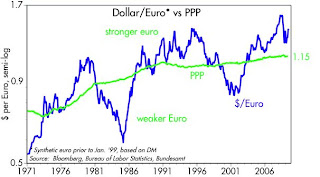
This is my chart of the purchasing power parity (PPP) of the euro versus the dollar. The green line is the PPP value of the euro, as I calculate it. It assumes a base year when prices in the U.S. and Europe were roughly comparable, and then adjusts that value according to inflation differentials between the U.S. and Europe. Since the line has an upward sloping trend, we know that Europe has for a long time had less inflation that we have had in the U.S.
Whenever the actual value of the euro is above the green line, the euro is "strong" relative to the dollar and U.S. tourists will find that things in Europe generally cost more than they do in the U.S. By my calculation, things cost roughly 20% more on average in Europe right now. If you go to Europe on vacation this summer, tell me if I'm right or not.





3 comments:
Well, I don't know. I'm in Italy right now. What I've always found over the years is the prices in Europe, for internationally recognized goods, are always the same in the local currency (unadjusted) as they are in dollars. So, something that costs $1.99 is always either 1.99 Euros or 1.99 pounds. This has been true for as long as I can recall, at least 20 years.
It's one of those things I don't understand. Shouldn't the law of one price at some point drive prices and make them converge? Why/how can the European price in local currency almost always be the dollar price, regardless of exchange rate?
Scott, any predictions for where the € : $ exchange rate is going?
Rob: I've never tried very hard to forecast or make money on currencies, but if I had to guess I would say the euro is going to continue on its upward trend which started last March. The monetary fundamentals would support that, since the ECB has not followed the Fed into panic easing mode, but rather seems more concerned about price stability and less concerned about the economy.
Post a Comment